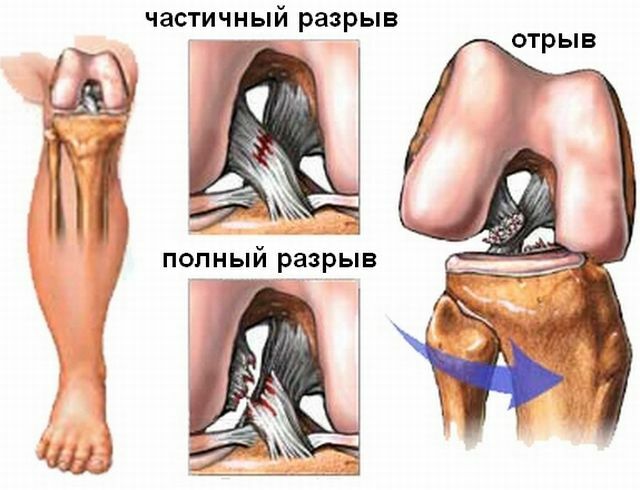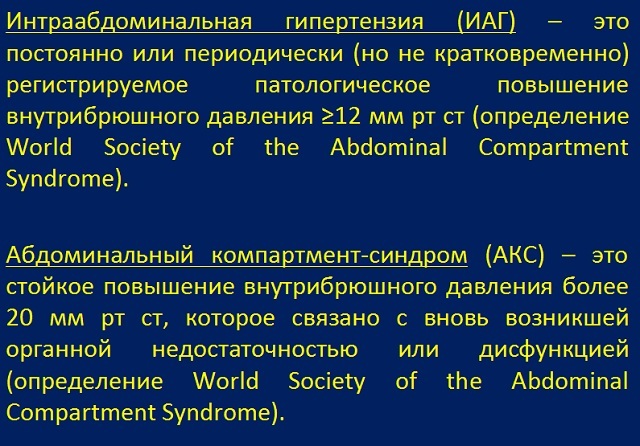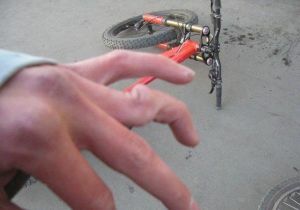 The ankle allows a person to freely move his foot, easily change its position and adjust, for example, to the terrain so as not to get additional injuries.
The ankle allows a person to freely move his foot, easily change its position and adjust, for example, to the terrain so as not to get additional injuries.
Joints enclose three groups of ligaments :
- Pentaxle peroneum. Refers to the outer surface. Together with it, the joint protects the talon-peroneum. They keep the talus bone from displacement;
- Deltoid. Passes on the inner side and consists of a surface and a deep layer, protecting the talus and scaphoid bone;
- A group of ligaments of , which consists of an intercostal syndesmosis, anterior intercellular and posterior transverse ligament.
Contents of the article
- The mechanism of injury
- Reasons for stretching
- Symptoms that indicate tension
- Extension levels
- Diagnostic procedure
- First aid
- Types of treatment procedures for trauma
- Conservative treatment
- Treatment with folk remedies
- Rehabilitation activities
- Forecast
- Consequences of stretching
- Video: What is the rehabilitation after the spread
The mechanism of the injury
The stretching of the ligaments isthe most common injury. What explains this pattern? This is due to the peculiarity of the ankle structure, which performs both the extensor and the flexural functions of the .It is this that can explain its instability.
In addition to such complex functions as the execution of the turns of the foot in different directions, the whole body weight is applied to the shin. The ankle ligaments not only hold together the appendages of the bones, but also are capable of retaining them from more serious injuries.
Their stretching occurs when they are unable to cope with an intensive amount of movements in a short period of time.
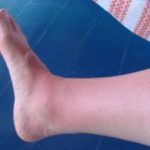 Why does joint inflammation occur on the legs? Symptoms of which illness can be inflammation and what you should pay attention to can be found in our article. How to treat Still's disease in adults? What is the pathology associated with and what solutions can you find here?
Why does joint inflammation occur on the legs? Symptoms of which illness can be inflammation and what you should pay attention to can be found in our article. How to treat Still's disease in adults? What is the pathology associated with and what solutions can you find here?
Reasons for stretching
To contribute to the appearance of such a trauma can not only a sharp change in the relief, excessive load on the foot, but many other reasons.
For example, some groups of people are prone to injury. This can include:
- Features of the structure of the foot , when its arch is located high;
- The supine type of ankle , in which the fingers are directed inwards;
- Muscular dysfunction. For example, their weakening with a lack of physical training;
- Nervous function of motor activity of is disrupted, which increases the probability of tucking the foot;
- Difference in length of lower limbs;
- Softening of the ligaments of , because of what they become weaker. But because of them, the bones are held together;
- Frequent stretching.
Many people have the opportunity to get a sprain of the ankle joints much higher than others. How to explain this feature?
- First, the has some diseases that can significantly reduce the ability of the ligaments to stabilize the joint.
- Secondly, is associated with excessive load on them. It is possible to single out even a group, which will include some people. The risk of their stretching will be very high.
Symptoms that indicate a stretch
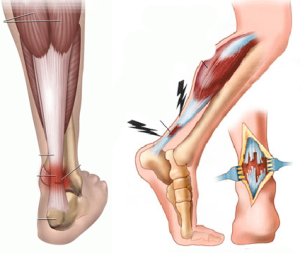
In the photo you can see where usually the sprains of the ankle joint
usually occur. In the presence of minor damage, not all people consider it necessary to contact the doctor, but later, with more vivid symptomatology, qualified help may be needed.
The signs of sprain of the ankle joint include the following:
- Pain. It increases if you try to use a limb, lean on it, or just touch it. This is explained by the presence of a huge number of nerve endings that permeate the bundle through and through. In many cases, with stretching, the pain syndrome will build up if you do not take any action;
- Hematoma. Its color is gradually replaced with a slight reddening to cyanotic color. If initially do not apply an ice pack to the ankle, the bruise can be very intense. Gradual elimination from it will occur naturally, but it can be accelerated with the help of ointments;
- Edema. It can also be reduced with a cold compress. The manifestation of swelling will depend on how extensive was the stretching;
- Temperature. Its increase can occur both locally and throughout the body. Its rise is explained by gradual development in the damaged bundle of the inflammatory process, or simply by reaction to the decomposition of the leaked blood;
- Hyperemia. A strong increase in blood flow makes the bruise more extensive, there is redness, puffiness is aggravated.
For detachment, it is more typical to have a click when trying to move the foot, an intense pain syndrome. The limb is completely immobilized when stretched, but when the ligaments are torn off, it usually moves with an unnatural amplitude.
Degree of extension
It is also characteristic that such a damage can be assigned its own category of severity. They can be conditionally divided into three degrees.
- The first is characterized by the rupture of a small number of individual binder fibers. Movement limb in this case can be performed with caution, and the pain is not so strongly pronounced.
- The second degree of is the tearing of the ligament, which makes it difficult to move the foot. In addition to puffiness and pain, a person remains incapacitated for some time, since it takes time to heal such damage.
- The third stage of , the main fibers of the ligament are damaged. Such a trauma is also called full transverse. Because of the very high pain syndrome, the foot is completely immobilized. For a long time, the limb function is lost, which in the future can negatively affect the joint, making its position unstable.
Diagnostic process
Diagnosis begins with a full-time examination of the doctor and conducting a survey. Usually this is followed by the appointment of radiography. This allows eliminating the possibility of more dangerous ankle damage.
First aid
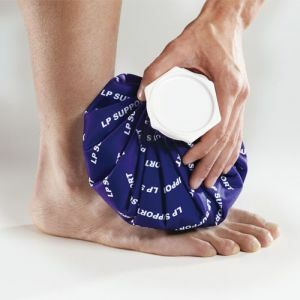 First of all, when stretching the ligaments of the ankle joint, remove the shoes from the injured limb and give the foot a more comfortable position. The best solution is to lay the on a hill and bandage it.
First of all, when stretching the ligaments of the ankle joint, remove the shoes from the injured limb and give the foot a more comfortable position. The best solution is to lay the on a hill and bandage it.
To tighten too tight is not recommended, so as not to cause unnecessary pain. By the way, to reduce it, should use a cold compress. This will also help reduce the appearance of bruising and swelling.
After the , the patient should be taken to the clinic for a more thorough examination, as it is important to exclude the possibility of more serious damage.
Types of treatment procedures for trauma
The impact measures for stretching the foot provide only the conservative type of treatment.
Surgical intervention is required only if there is a rupture of the ligament of the foot. But in addition to the methods of influence that will be recommended by doctors, you can also use some methods of restoring limb functions taken from traditional medicine.
Conservative treatment
For the immobilization of the limb, uses several types of the shroud. Among them, can distinguish the following:
- "Eight". "Sock" type dressing for fixing the foot in one position;
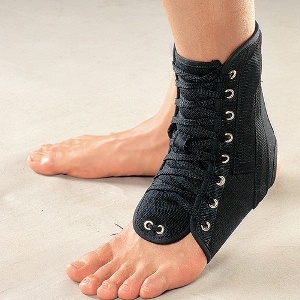
orthosis
- Orthosis. It is used as a complete fixation method. The foot is snug against the device;
- Plaster cast. It is considered the most common way of immobilizing the foot. Successfully replaced with orthosis;
- Elastic bandage .Helps to remove swelling, as well as improves the effect of the ointment and is not able to irritate the skin. It is considered an easy way of fixing. Its characteristic feature is the possibility of warming the joint.
In addition to fixing the ankle, also uses other methods aimed at the speedy recovery of the foot:
- Anesthesia. Analgesics can be prescribed if the pain syndrome is too strong. Further tablets are completely canceled;
- Ointments. Used topically and can fully replace painkillers. When stretching the ligaments of the ankle joint, ointments with a cooling effect are used, but warming will be used to accelerate the blood circulation at the site of injury. In addition to the described effects, they also reduce the severity of edema and help fight inflammation;
- Drugs, required for anti-inflammatory therapy. For example, those that contain Diclofenac;
- Self-massage. Because the damage is not too significant, these events can be carried out independently. The most effective measure of impact will be if you massage with ointment.
- exercise therapy. As soon as the pain becomes less and foot movements are possible, you should start doing light exercises. They will allow you to quickly restore the stretched muscle and bring it into a tonus.
Treatment with folk remedies
Some measures borrowed from traditional medicine help to cope with the symptoms of stretching and allow you to get back on your feet faster.
It is recommended to use compresses from milk. Preliminary it should be heated.
- You can prepare the mass from the onion , mix it with a large salt and put it on a wound covered with gauze beforehand. This will allow you to decontaminate the damage, as well as remove excess water from it, which will perfectly cope with excessive edema.
- In the same way, the gruel prepared from pre-grated raw potatoes can also be used.
- Also help to provide additional anti-inflammatory effect of decoctions from the bark of oak, chamomile, St. John's wort. With their help you can make warm compresses, or simply add their infusions to the bathroom.
Rehabilitation activities
Once treatment of sprain of the ankle joint, performed with the help of ointments and prescriptions of traditional medicine is over, it is possible to proceed with joint restorative measures and develop its former elasticity.
This can be done with self-massage and exercise therapy .You can also actively use physiotherapy procedures: phono and electrophoresis, UHF, mud or paraffin treatment.
With intensive rehabilitation measures, lameness and pain usually disappear after one and a half to two weeks.
Forecast
In most cases, the stretch is fully consolidated. Restoration of elasticity is due to intact sections of the articular ligaments.
Consequences of stretching
As a rule, no serious consequences of stretching the ligaments of the ankle after it lead to failure if the treatment was started in a timely manner.
If the visit to the doctor did not follow, then is highly likely that the self-diagnosed diagnosis will be incorrect. The usual sprain of the ankle can hide much more serious problems.
In addition, if treatment has not been carried out, it will lead to instability later on. In the future this can cause new ankle injuries.

